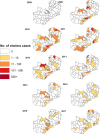Identification of cholera hotspots in Zambia: A spatiotemporal analysis of cholera data from 2008 to 2017
- PMID: 32294084
- PMCID: PMC7159183
- DOI: 10.1371/journal.pntd.0008227
Identification of cholera hotspots in Zambia: A spatiotemporal analysis of cholera data from 2008 to 2017
Abstract
The global burden of cholera is increasing, with the majority (60%) of the cases occurring in sub-Saharan Africa. In Zambia, widespread cholera outbreaks have occurred since 1977, predominantly in the capital city of Lusaka. During both the 2016 and 2018 outbreaks, the Ministry of Health implemented cholera vaccination in addition to other preventative and control measures, to stop the spread and control the outbreak. Given the limitations in vaccine availability and the logistical support required for vaccination, oral cholera vaccine (OCV) is now recommended for use in the high risk areas ("hotspots") for cholera. Hence, the aim of this study was to identify areas with an increased risk of cholera in Zambia. Retrospective cholera case data from 2008 to 2017 was obtained from the Ministry of Health, Department of Public Health and Disease Surveillance. The Zambian Central Statistical Office provided district-level population data, socioeconomic and water, sanitation and hygiene (WaSH) indicators. To identify districts at high risk, we performed a discrete Poisson-based space-time scan statistic to account for variations in cholera risk across both space and time over a 10-year study period. A zero-inflated negative binomial regression model was employed to identify the district level risk factors for cholera. The risk map was generated by classifying the relative risk of cholera in each district, as obtained from the space-scan test statistic. In total, 34,950 cases of cholera were reported in Zambia between 2008 and 2017. Cholera cases varied spatially by year. During the study period, Lusaka District had the highest burden of cholera, with 29,080 reported cases. The space-time scan statistic identified 16 districts to be at a significantly higher risk of having cholera. The relative risk of having cholera in these districts was significantly higher and ranged from 1.25 to 78.87 times higher when compared to elsewhere in the country. Proximity to waterbodies was the only factor associated with the increased risk for cholera (P<0.05). This study provides a basis for the cholera elimination program in Zambia. Outside Lusaka, the majority of high risk districts identified were near the border with the DRC, Tanzania, Mozambique, and Zimbabwe. This suggests that cholera in Zambia may be linked to movement of people from neighboring areas of cholera endemicity. A collaborative intervention program implemented in concert with neighboring countries could be an effective strategy for elimination of cholera in Zambia, while also reducing rates at a regional level.
Conflict of interest statement
The authors have declared that no competing interests exist.
Figures





References
-
- Ali M, Nelson AR, Lopez AL, Sack DA. Updated Global Burden of Cholera in Endemic Countries. Remais J V., editor. PLoS Negl Trop Dis [Internet]. 2015. June 4 [cited 2018 Feb 10];9(6):e0003832 Available from: http://dx.plos.org/10.1371/journal.pntd.0003832 - DOI - PMC - PubMed
-
- WHO. CHOLERA COUNTRY PROFILE: ZAMBIA [Internet]. Lusaka; 2011 [cited 2017 Aug 21]. Available from: http://www.who.int/cholera/countries/ZambiaCountryProfile2011.pdf?ua=1
-
- Francisco L, Elisabeth S. Cholera outbreak in Lusaka, Zambia:2008–2009 and analysis of historical cholera data: 2005–2007. 2009;
-
- ZNPHI. SITUATION Report- Cholera Zambia. 2018.
-
- Mengel MA, Delrieu I, Heyerdahl L, Gessner BD. Cholera Outbreaks in Africa. In Springer, Berlin, Heidelberg; 2014. [cited 2018 Aug 18]. p. 117–44. Available from: http://link.springer.com/10.1007/82_2014_369 - DOI - PubMed
Publication types
MeSH terms
LinkOut - more resources
Full Text Sources
Medical

